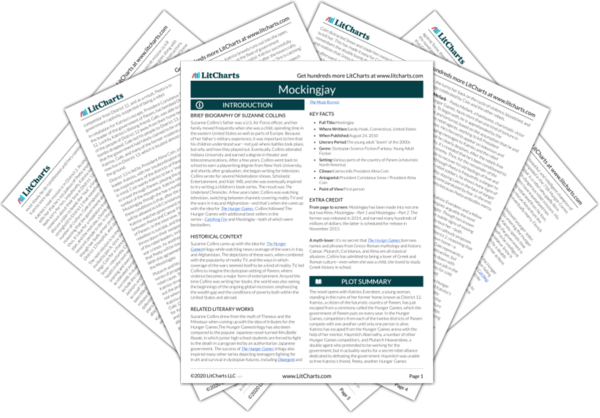Revolution and Its Problems
The psychoanalyst Jacques Lacan argued that there was a contradiction built into the word “revolution.” A political revolution, in the minds of most, is a sudden, monumental change—a great leap forward. At the same time, “revolution” can also mean a complete, 360-degree turn, right back to one’s original position. Thus Lacan concluded that revolutions don’t always lead to the great changes they promise. Often, things just stay the same. Or as the band The Who…
read analysis of Revolution and Its ProblemsThe Power and Danger of Symbols
From the very beginning of Mockingjay, it’s made clear that symbols are of the utmost importance in the war between the government of Panem and the rebel alliance. The leader of the rebels, President Alma Coin, asks Katniss to play the part of Mockingjay: to be the embodiment of the rebels’ energy, courage, and desire for change.
When Katniss agrees to do so, it becomes clear that the Mockingjay is a key part…
read analysis of The Power and Danger of SymbolsRole-Playing, Authenticity, Television, and the Self
In Catching Fire, the prequel to Mockingjay, Katniss is forced to “perform” before all of Panem. Embarking on her Victory Tour, she’s instructed to make a few speeches, smile and wave, and honor the rules of the government headed by President Snow.
In Mockingjay, Katniss, now working with a rebel alliance trying to bring down Snow’s government, is given a subtly different kind of script to follow. Just as before, a…
read analysis of Role-Playing, Authenticity, Television, and the Self
Compassion, Callousness, and Revenge
In Mockingjay, even more overtly than in Catching Fire or The Hunger Games, Collins writes about the conflict between compassion and callousness, or, in a slightly different sense, between forgiveness and revenge.
The rebel alliance headed by President Coin commits numerous war crimes in its haste to defeat the government of President Snow: it bombs civilians, imprisons its own people, and even commits atrocities that it then tries to pin on Snow…
read analysis of Compassion, Callousness, and RevengeTrauma and Love
As the Hunger Games trilogy moves to its conclusion, Katniss struggles with more and more traumatic experiences. In Mockingjay alone, she witnesses her own sister being killed by a bomb, and her close friends having their legs blown off and their faces melted. How does Katniss—and, for that matter, the other characters in Mockingjay who lose loved ones—cope with trauma?
In general, the characters who experience the greatest trauma—those who lose loved ones to war…
read analysis of Trauma and Love






